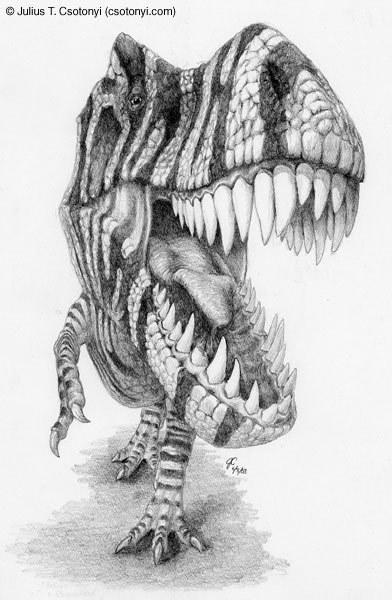T. Rex's Bite More Dangerous Than Previously Believed

The tyrant lizard, also known as Tyrannosaurus rex, had the strongest bite of any known land animal, new research suggests.
"Our results show that the T. rex had an extremely powerful bite, making it one of the most dangerous predators to have roamed our planet," study researcher Karl Bates, of the University of Liverpool, said in a statement.
Younger T. rexes didn't have such strong bites, the researchers found, which probably meant they had a different diet and relied less on the fearsome bite than their older counterparts. This differing diets likely led reduced competition between generations of T. rex, the researchers said. [Image Gallery: The Life of T. Rex]
Fearsome bite
The new estimate of bite force is higher than past estimates that relied on indent measures in which they pressed down the skull and teeth onto a bone until they got the imprints that matched those on fossils. In the new study, the researchers created a computer model of the dinosaur's jaw by first digitally scanning skulls from an adult and juvenile T. rex, an allosaurus, an alligator and an adult human. They used these scans to model each animal's bite.
"We took what we knew about T. rex from its skeleton and built a computer model," Bates said. "We then asked the computer model to produce a bite so that we could measure the speed and force of it directly."
The force exerted at one of T. rex's back teeth would have been between 7,868 and 12,814 pounds-force (35,000 and 57,000 newtons). This force would be akin to having a medium-size elephant sit on you.
Get the world’s most fascinating discoveries delivered straight to your inbox.
Young vs. old
The shape of T. rex's skull allowed room for lots of muscles, creating what is "by far the highest bite forces estimated for any terrestrial animal," the researchers write in the paper, to be published tomorrow (Feb. 29) in the journal Biology Letters, but it is possible the extinct gigantic shark Megalodon had a stronger bite.
"If you consider that the lion and alligator [bite strength] are so much lower (as reported in our paper), and think of what they can bite through, that can give you a sense of the power in a T. rex bite," study researcher Peter Falkingham, of the University of Manchester in the United Kingdom, told LiveScience in an email. "Such a powerful bite may have enabled T.rex to crush large bones."
(Past research has suggested T. rex's fused nasal bones boosted its bite force, while also keeping the predator's skull from breaking from a serious chomp.)
Even when Falkingham and colleagues scaled the models for body size differences, this bite was relatively much stronger than the bite of a juvenile T. rex. In its early years of life, T. rex's bite was weaker, but the young dinosaurs might have also been more athletic and had longer arms in proportion to their body size, previous research has suggested.
These differences could mean that the dinosaur's diet would have changed over time — starting on smaller prey, but growing into a ferocious predator to even the largest animals as it matured. These dietary differences would have reduced competition between older and younger T. rexes, Falkingham said.
You can follow LiveScience staff writer Jennifer Welsh on Twitter @microbelover. Follow LiveScience for the latest in science news and discoveries on Twitter @livescience and on Facebook.
Jennifer Welsh is a Connecticut-based science writer and editor and a regular contributor to Live Science. She also has several years of bench work in cancer research and anti-viral drug discovery under her belt. She has previously written for Science News, VerywellHealth, The Scientist, Discover Magazine, WIRED Science, and Business Insider.



